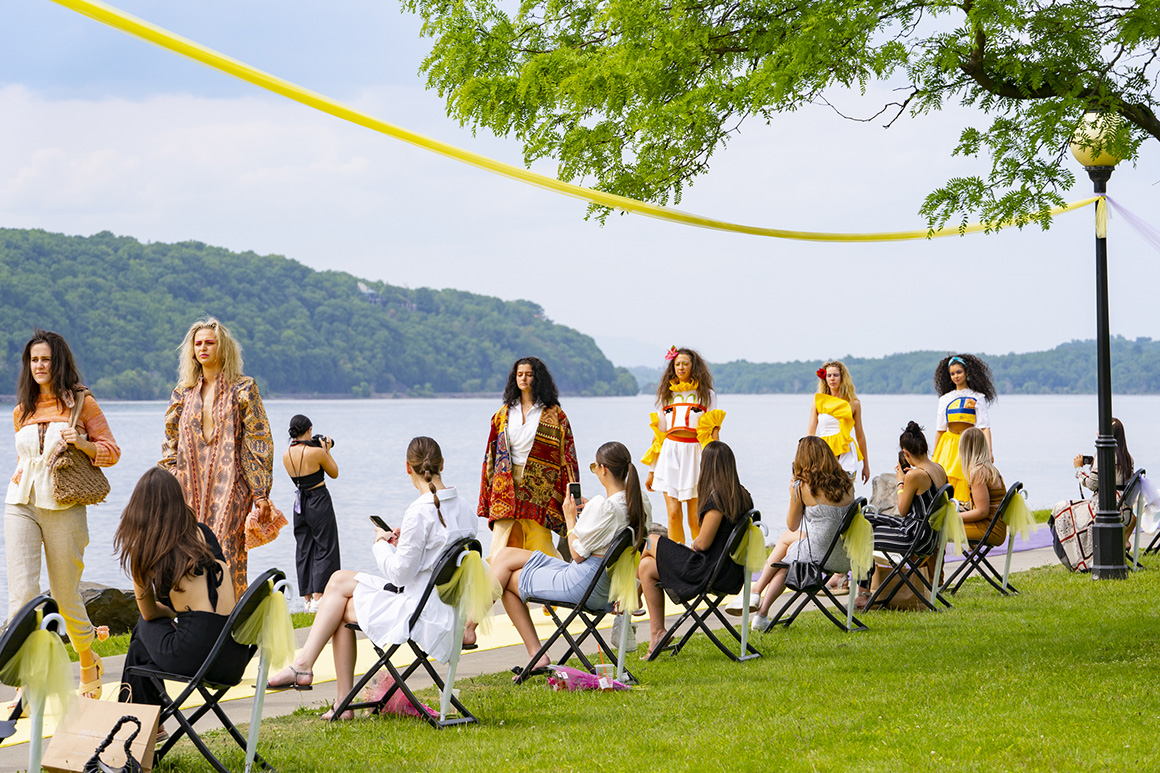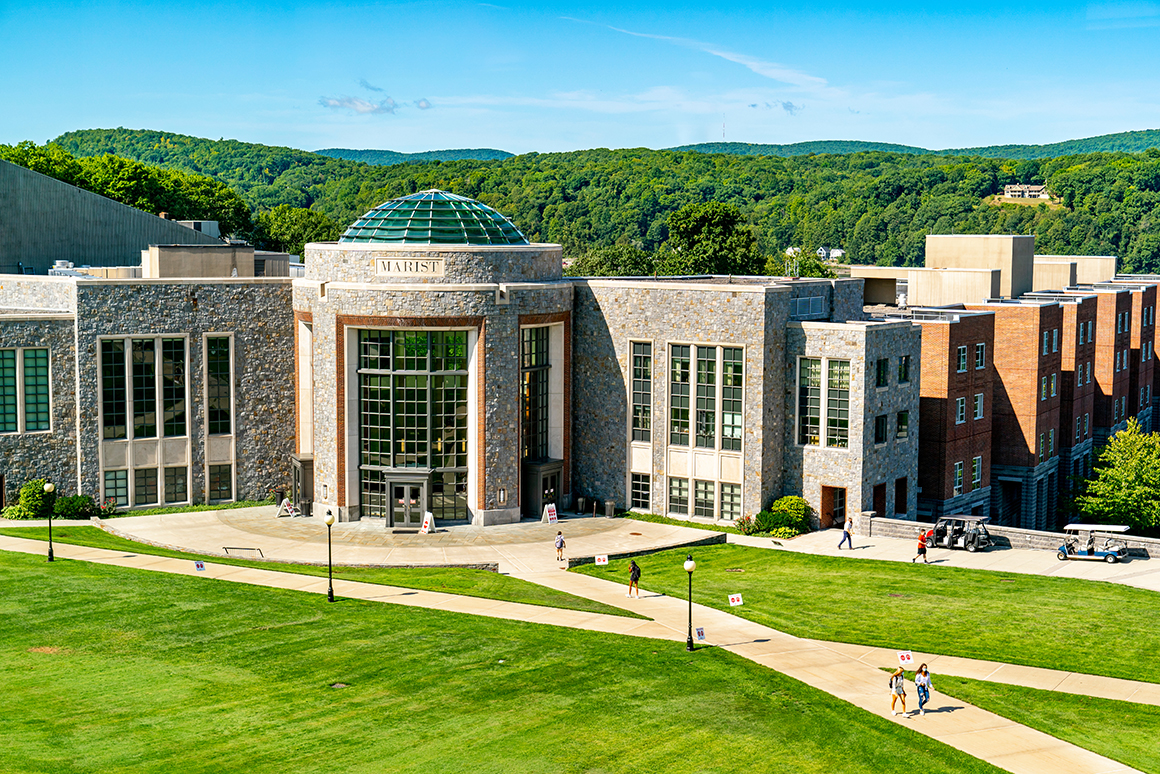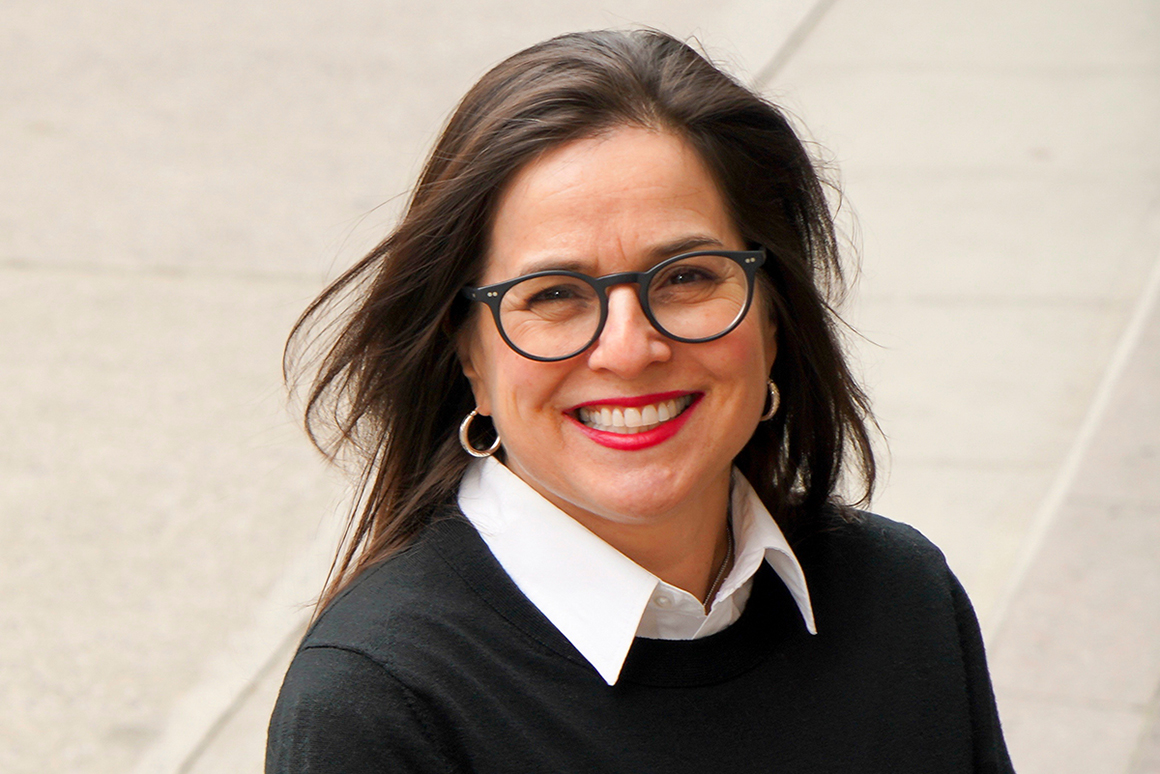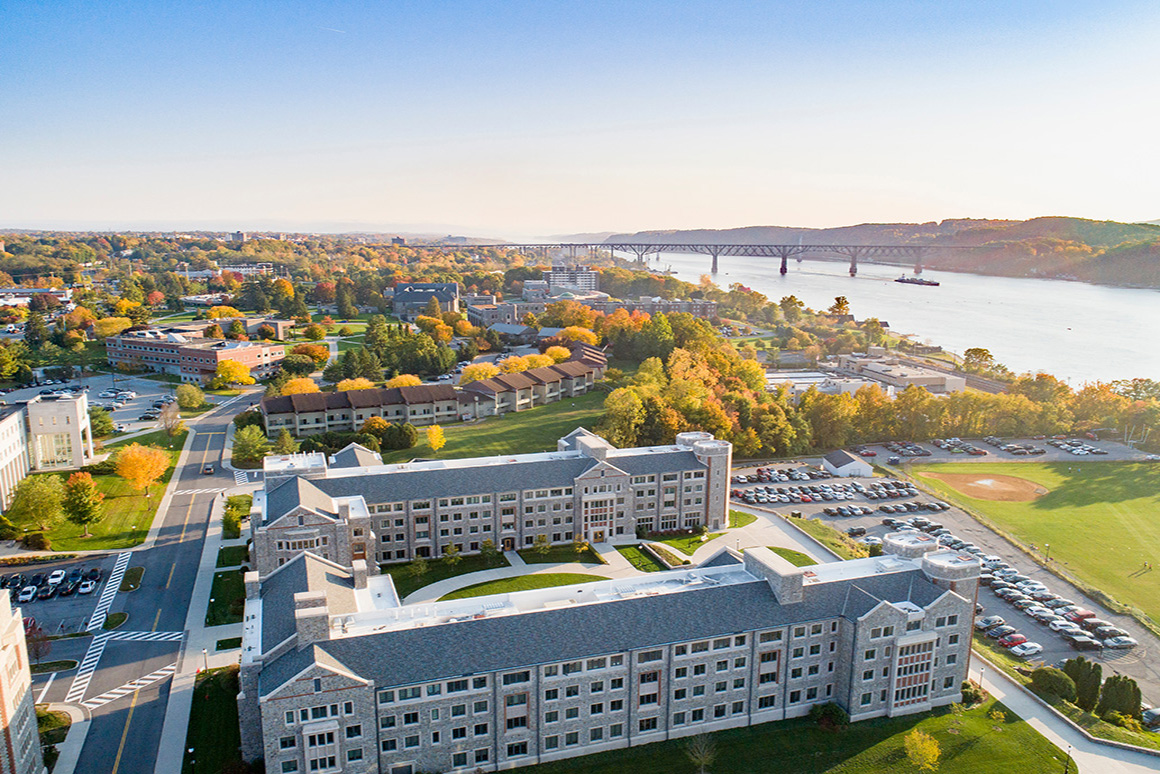Spring 2025

On Saturday, May 22, the sidewalk along the Marist riverfront popped with a blue, orange, purple, and yellow covering, each color taking up a roughly 20-foot strip of the carpet that stretched from the Marist Boathouse to the very end of the walkway.
On Saturday, May 22, the sidewalk along the Marist riverfront popped with a blue, orange, purple, and yellow covering, each color taking up a roughly 20-foot strip of the carpet that stretched from the Marist Boathouse to the very end of the walkway. The light posts were decorated with streamers matching the corresponding color on the ground. Folding chairs were set up six feet apart alongside the grass, facing the river. Marist students lined up inside the boathouse, flaunting the creations by their classmates, ready to walk the runway for the 35th annual Silver Needle Runway Show. “Open your eyes past the distorted lenses you have built,” a voice implored through the speakers placed behind the audience before the models began their strut. “Liberate your mind to the world beyond your perspective. Now, what will you see?”The producers of the SNR show had been asking themselves that question for roughly a year. Bringing the show back to an in-person spectacle took exhaustive planning. After SNR 34 had to transition to a completely online venture because of the pandemic, this year’s edition of the Marist Fashion Program’s annual show looked, unlike any show before it. It was outside. There was a virtual show in addition to the in-person one. It was an entirely student-produced show, save for the efforts of Faculty Director Juan-Manuel Olivera-Silvera. Several factors changed in the show’s production that made it happen. The most impactful change was the omittance of outside help. Due to a crunched budget and social distancing guidelines to follow, there was no outside production company or experienced professional model corps at the SNR team’s disposal, unlike in years past. The production team had to make do with the resources they had. Olivera-Silvera — who is a senior professional lecturer of fashion and the Fashion Program’s internship coordinator in addition to being the SNR faculty director — wants SNR to be a “laboratory of innovation” for his students. They had to make the laboratory look different this year, but still, the experimentation produced results that the team was proud of.The student production team for this 35th edition of SNR was formed shortly after the virtual 2020 show. They started meeting on Zoom to get to know each other before working more with the show during the school year. Creative Director Ariana Pittelli ’21 took the reins on the “aesthetic visual” — the color palette and story that created the theme they wanted to express. Production Directors Kennedi Hudnut ’21 and Elizabeth Knight ’21 organized three sub-teams: model, wardrobe, and logistics. All in all, more than 30 students came together to tackle the production aspect of the show.The 18 designers, all of whom were seniors, created their outfits with the theme SNR35: illusion in mind. “Our whole goal is to give a deeper message about how your perspective is similar and we all see the world differently, but we need to recognize that and try to undo some of the walls we’ve built,” Pittelli said. Since working around the coronavirus pandemic was the theme of last year’s show, they wanted to do something different while still providing a meaningful, relevant message. “We thought a lot about the societal issues going on, like Black Lives Matter, and all the prejudice in our world,” Pittelli said. “We wanted the show to be a chance to recognize that and give people the message of, ‘We need to undo this illusion.’ ” Designer Jenna Mitarotonda took inspiration from traditional Scottish clothing by incorporating plaid designs and shades of red and light brown into all her designs. Her collection featured skirt-like shapes with baggy sleeves and black boots. She started designing the collection in the fall. Sketching the idea is the first part, followed by draping — taking pieces of fabrics and applying them on a dress form — and then making the actual garments, some of which were scrapped or redone. “I would say this whole design process is trial and error because you learn from your mistakes, or sometimes mistakes are actually really successful,” Mitarotonda said.The trial-and-error nature of collection designing is the same across the board, but the actual steps are not. Designer Natalie Ford is not a fan of draping. Instead, she focused on pattern making, which she took a class in and developed a knack for. She found inspiration in grocery stores, an idea she had had since freshman year. Her collection featured two ensembles with bright colors reminiscent of candy and one dress depicting waffles, accessorized by a round handbag with a waffle design and golden-brown color. Chloe Goldstein’s collection took inspiration from Morocco, which she visited for a few days while studying abroad in Italy in the fall of 2019. She utilized her line of handmade macrame bags in her pieces. Her collection focused on sustainability. She omitted the use of non-natural fibers and toxic dyes and sourced everything from small vendors. It took more time, research, and connecting with small businesses to make her collection, but for her, it was well worth the effort to make it more eco-friendly. The models for the show were all students. Hailey Keenan, a sophomore majoring in fashion merchandising, was selected as a model for Jenna Mitarotonda’s collection. Her only experience modeling had been for a capping project last year. She sent an audition video and auditioned in person before being selected to model Mitarotonda’s collection. Keenan and two other models met with Mitarotonda a week before the show for fitting. Production Director Kennedi Hudnut said that the team working out the logistics themselves and having only fellow students at their disposal involved a big learning curve. They didn’t realize the entirety of the picture that went into logistics, which included obtaining fire inspections and permits. “Stuff like that, we never thought we’d have to do being in the fashion show production class,” she said prior to the show. “But I think it’s going to make us grow stronger as a class and it’s really a great thing to know that it’s all student-run, from top to bottom.” The SNR project served as a capping class for Fashion students but was open to students of any major within the School of Communication and the Arts. The expansion drew students with a wide array of skills. And the production crew needed to reach even further within the Marist community to make the show go. Pittelli said they tapped several departments to set up certain aspects of the show — Athletics for tents, IT for Wi-Fi hotspots, the Marist Media Center for live-streaming capabilities. She added that the sense of feeling rewarded is not due just to their hard work, but because they’re setting up the group of younger students to take the reins and continue to thrive. Along with the in-person show, the SNR team created virtual content. They streamed the show live on Vimeo, using multiple camera angles and shots A 12-minute YouTube video shows the models’ walks around the Colonel Oliver Hazard Payne estate, a mansion owned by Marist 20 minutes north of the main campus on the west side of the river. They also created a documentary and a 17-minute film titled What you’ll see. The story follows Eliza, a young woman, going through the motions of her life without trying to find much more.“The virtual show has a greater reach than you could ever have with an in-person show, so that’s really important,” Pittelli said. “We’re always thinking about the future of the class, the future of the Fashion Program, the future of the industry, and [we] try to instill that into our teams and give them the experience they need moving forward in the industry. So it only made sense to do this.”Olivera-Silvera said the pandemic forced the fashion industry into some introspection. He said that due to the high costs and the copious amounts and forms of waste— trash, electricity, energy— that fashion shows produce, the current system wasn’t sustainable. “The pandemic has brought to light the fact that the industry needed to change, and the virtual platforms have been an amazing vehicle to bring that change,” he said. “Going forward, I think the virtual show will always be something that Marist Fashion does,” Production Director Elizabeth Knight said.The SNR show has been a staple of Marist Fashion for decades. But now they’re looking to become more than that. Leaning heavier into digital content is just one of the ways they’re doing so. SNR started a newsletter called “Through the Needle”, a four-part publication that took readers behind the scenes of the show. They also launched “More Than Fashion: The SNR Podcast,” a five-episode series that discusses different aspects of fashion with a guest. SNR launched their own social media accounts rather than use those of the Fashion Program. “It’s all about creating buzz for us,” Pittelli said. “We’re trying to make SNR not just a school fashion show, but a brand.”The College already has a strong reputation as a school for the study of fashion. This past May, Forbes named Marist one of the “Best Colleges That Are Shaping the Future of Fashion.” Forbes lists only 10 programs worldwide, only four of which are in the United States.The efforts to further expand as a brand went down to the wire during the week of the show. Olivera-Silvera consulted three different weather apps to ensure the team would be ready for anything. They prepped for bad weather by placing umbrellas behind every seat, stashing some for the models, and putting a rain date in place. Luckily, it wasn’t needed, as the weather was cooperative enough for the show to go on.Everyone came together the night before the event for a dress rehearsal around 5:00. A tent on the side of the boathouse, out of the sight of visitors, served as their headquarters. Olivera-Silvera gave instructions about walking paths for the models and pitched in to help where it was needed as everyone prepared for a test run. Models changed into their outfits on the second floor of the boathouse, which was restricted to everyone but the models themselves and a few SNR staffers. The first floor had water bottles, snacks, wipes, cotton swabs, lint rollers, hair straighteners, cotton balls, and more. SNR staffers strung a banner across the opening of the boathouse to mark the start and end of the runway. Members of the SNR creative team manned the upstairs balcony, working with the video and sound side of the operation after the models were ready. The models started their walk in the tent and through the first floor of the boathouse. They began their first practice run around 6:30. Olivera-Silvera watched from the side, offering tips to models as they walked. A few practice runs later, the only thing left to do was put on the show the next day. Or actually, to put it on five times: to accommodate the large audience SNR always draws, they organized five shows debuting every half hour, beginning at noon and ending with their last show at 6:00.On the day of the event, the SNR team’s check-in station featured two big tents with other elements of the show and the Fashion Program to explore — merchandise tables for SNR and Mporium, a student-run boutique, a funhouse mirror painted with SNR colors, a table promoting the new student-run magazine Measure, and a separate tent showing a short film on a projector. John Bartlett, the director of the Fashion Program, spoke to the SNR production students before the show. “What you all have accomplished this year is Herculean.”He also addressed the audience at the start of the event. “Design students, you have simply moved me with your talent, your creativity, and your natural gifts — and also, your ability to lift each other up. You are all going to go very far in this industry and in life.”To see a video of SNR35, go to www.marist.edu/snr35. For related media, go to https://linktr.ee/silverneedlerunway
10 Jun 2021

The College’s bachelor’s degree program in professional studies, master’s degree in business, and MBA program were named “Best Online Programs” by U.S. News.
Three of Marist College’s online offerings were ranked in U.S. News’s “Best Online Programs” lists for 2021.The programs included are the bachelor’s degree program in professional studies; master’s degree in business (non-MBA); and master’s in business administration (MBA).An early adopter of online programming, Marist has long been a leader in distance learning. This wealth of experience benefited the College greatly when all courses pivoted to fully remote during the spring 2020 semester due to COVID-19. In fall 2020, the College had a successful in-person reopening with courses ready to switch to online if needed.“We appreciate the continued recognition from U.S. News for our online programs. The College is fully committed to innovation and the online format benefits a variety of students—including working adults—by delivering flexible, rigorous, and efficient programs that lead to career-enhancing degrees. The lifetime value of a college degree has been well-documented; it is imperative to offer higher education opportunities that are widely accessible,” said Sean P. Kaylor, vice president for enrollment, marketing, and communication.For the 2021 ”Best Online Programs” ranking, U.S. News assessed a record 1,641 online programs. The list measures overall academic quality; complete rankings are available at usnews.com.Marist prides itself on flexibility in its offerings to reach students of all backgrounds and life situations. Recognized program highlights include:Marist’s Online BA/BS Majors in Professional Studies and Management StudiesThe professional studies major is an integrative, accelerated bachelor's degree completion pathway that can be customized to draw upon previous college, service, and professional experience while learning new career-related skills. Multiple degree concentration options and accelerated eight-week courses, in both online and hybrid formats, allow adult students to tailor this option to meet their interests and career goals and finish on a schedule that suits their needs. For more information on Marist’s online BA/BS in professional studies, visit the School of Professional Programs website.The management studies major is designed for the adult learner who is motivated to advance their career. A compact yet comprehensive general management curriculum forms the heart of this accelerated bachelor’s degree completion program. It is designed to combine the insights of the Marist faculty with guidance from practicing professionals.Marist’s Online Business Graduate ProgramsMarist offers a 100 percent online master’s degree in public administration. The MPA program features distinct areas of concentration including ethical leadership, healthcare administration, public management, analytics, and nonprofit management. The MPA program is accredited by NASPAA (Network of Schools of Public Policy, Affairs, and Administration), the recognized global accreditor for graduate programs in public policy, public affairs, public administration, and public and nonprofit management. In 2018, Marist launched a master’s in professional accountancy program.For more information about these offerings, visit the School of Management’s MPA and MS in professional accountancy siteMarist’s Online MBAMarist launched New York State's first AACSB-accredited 100 percent-online MBA program in 1998, one of the first such programs in the nation. AACSB is the premier business school accrediting body. Also known as the Association to Advance Collegiate Schools of Business, it accredits fewer than five percent of business programs worldwide. The program was recently recognized by The Princeton Review as a Top 50 Online MBA Program.For more information on the Marist MBA program, visit the MBA program website.

Dr. Jacqueline Reich has been appointed dean of the School of Communication and the Arts, effective Monday, July 12. Reich has a robust background in higher education and brings a wealth of knowledge to Marist.
Dr. Jacqueline Reich has been named dean of the School of Communication and the Arts.Reich came to Marist from Fordham University, where she was professor of communication and media studies and recently finished a seven-year term as chair. She was also a member of the doctoral faculty at the University of Florence’s History of Art and Performance PhD program. As department chair, she oversaw the creation of four undergraduate majors and five new minors, an interdisciplinary program in new media and digital design, and a new master’s program in public media. Under her leadership, enrollments grew 40 percent in undergraduate and 50 percent in graduate programs. In addition, she supervised more than 60 full-time and part-time faculty. Prior to Fordham, Reich spent 18 years as an assistant and then associate professor of cinema and cultural studies at Stony Brook University. There she was responsible for the revision of three undergraduate majors and two minors, participated in the merger of two departments into one, and supervised a staff of nine in her role as faculty director of the Undergraduate College of Arts, Culture, and Humanities. During her career she has served on a number of university-wide committees. Reich is the author of two books and co-author of another, including The Maciste Films of Italian Silent Cinema (Indiana University Press, 2015), which won Best Book on Film and Media from the American Association of Italian Studies and was a finalist for the Best Book on Film for the Theatre Library Association. Other honors and awards include a visiting professorship at the University of Florence and a Howard Fellowship from the George A. and Eliza Gardner Howard Foundation at Brown University. She has an MA and PhD from the University of California at Berkeley and a BA from Dartmouth College. She divides her time between Yonkers and Garrison, NY, with her husband, two sons, and two dogs.

Marist is once again recognized as a Top and Most Innovative institution in the Regional Universities–North category.
Marist was once again recognized as a Top 10 Regional University – North by U.S. News and World Report. In addition, the College was also named one of the Most Innovative Schools in the region (#2 overall) and highly ranked for its focus on undergraduate teaching (#7 overall). These last two rankings are based upon surveys of college presidents, provosts, and admissions deans who were asked to nominate schools making substantial innovative improvements in the higher education industry.“Over the last decade Marist has been very intentional in how we have built our academic programs, which combine very distinctive educational opportunities and high-impact global experiences with an intimate liberal arts approach that provides highly personalized attention from faculty,” said Thom Wermuth, vice president for academic affairs. “These are the very reasons why our students are very satisfied with their experience at Marist and are highly successful after graduation.” A few of these areas are highlighted below:Study abroad: Study abroad is one of many experiential learning opportunities that add value to the Marist experience for students. Ranked #3 in the United States for study abroad by Open Doors Report, Marist creates pathways for its students to grow by utilizing the world as a classroom. Marist offers two very unique full-year study abroad programs for first-year students in Florence, Italy, and Dublin, Ireland. Marist’s Florence branch campus was founded to be the international face of the College’s commitment to global education and serves as the hub for our study abroad program. Over 50 percent of all Marist students study abroad during their undergraduate experience.Real-world experience: Marist has created numerous Centers of Excellence at its main campus in New York that provide unique opportunities and combine in-classroom learning with real-world professional experiences. These centers include the Hudson River Valley Institute, the Marist Poll, the Marist/IBM Joint Study, the Center for Civic Engagement and Leadership, and the Center for Sports Communication, among others. In addition, Marist has established significant partnerships with industry leaders including but not limited to the FDR Presidential Library & Museum, ESPN, and American Red Cross, to name a few. The College leverages these relationships to enhance the educational experience for our students. Approximately 85 percent of Marist students participate in at least one credit-bearing internship during their undergraduate experience. Accelerated degree programs: Marist currently offers six dual degrees which provide students with unique and affordable options to work toward their bachelor's and master's degrees simultaneously. Through these programs, students streamline their academic journey and are equipped with the knowledge and skills to enter the workforce. Dual degree programs offered at Marist include:• Accounting (BS)/Professional Accountancy (MS)• Communication (BA)/Integrated Marketing Communication (MA)• Computer Science (BS/MS)• Information Systems (BS/MS)• Teaching (BA/MA)• Psychology (BA)/Educational Psychology (MA)Marist’s first-rate educational experience is validated by its students. Ninety-five percent of students are satisfied with their college experience, highlighted by a strong first-year retention rate of 88 percent. Marist’s graduation rate is among the highest in the country at 85 percent, and following graduation, its five-year rolling average indicates that 97 percent of students are employed or enrolled in graduate school within six months.
21 Sep 2021